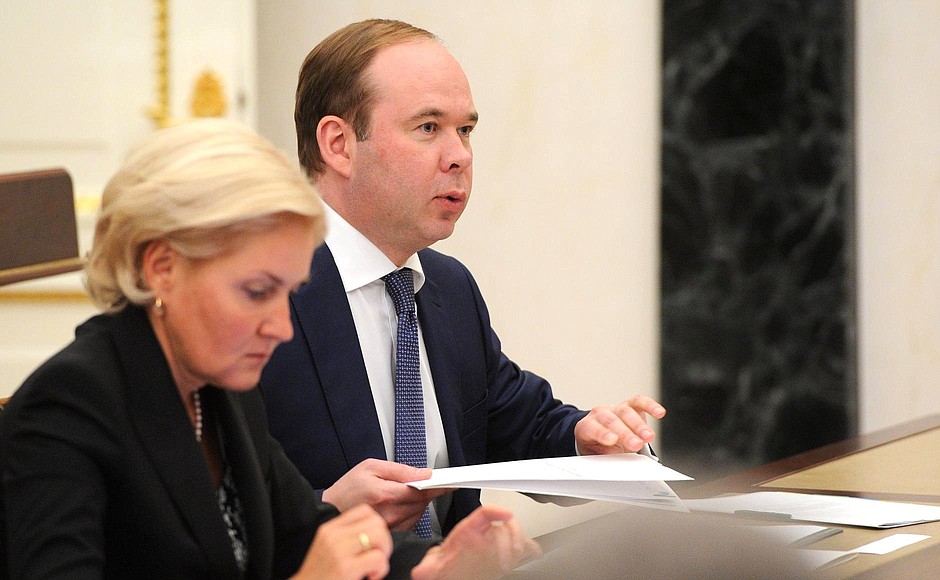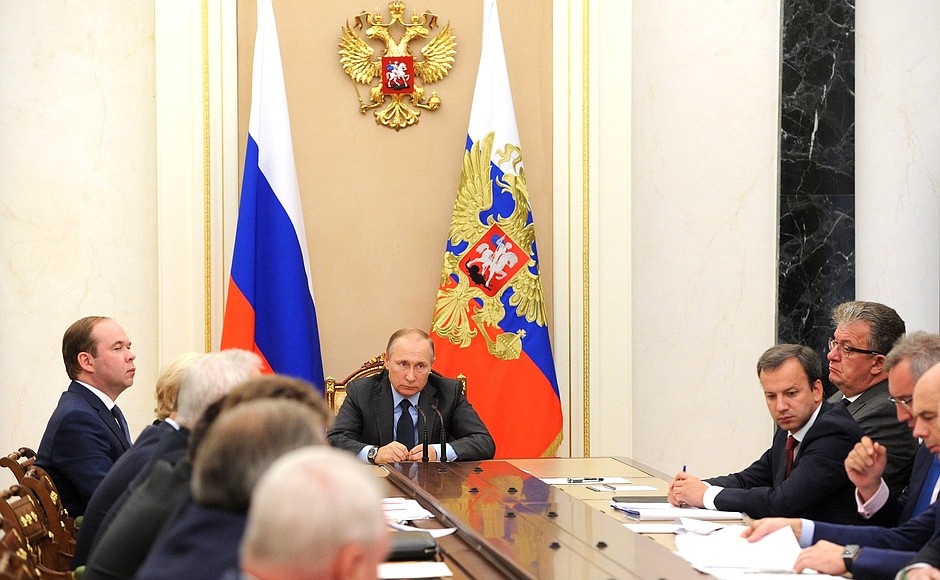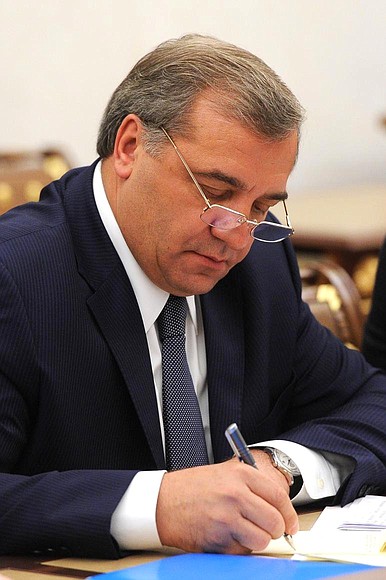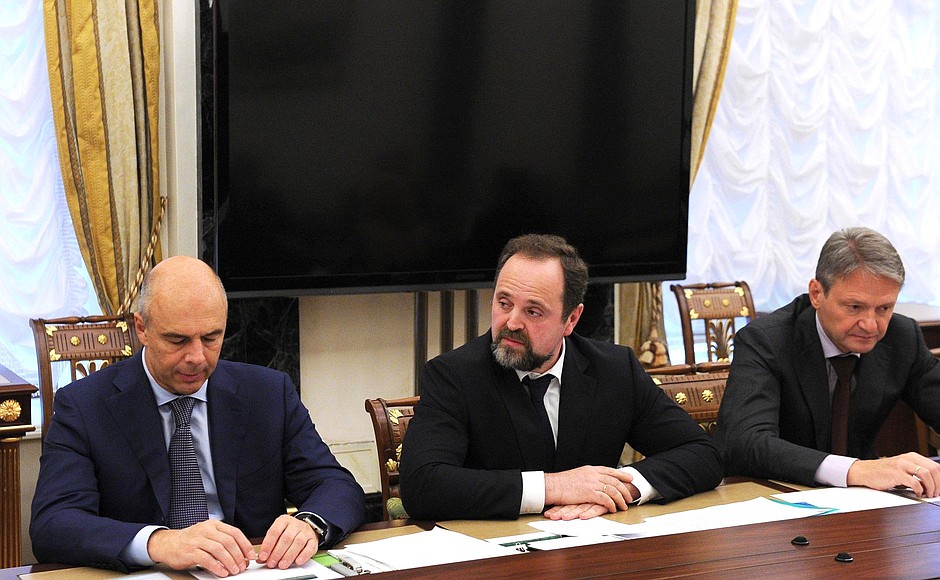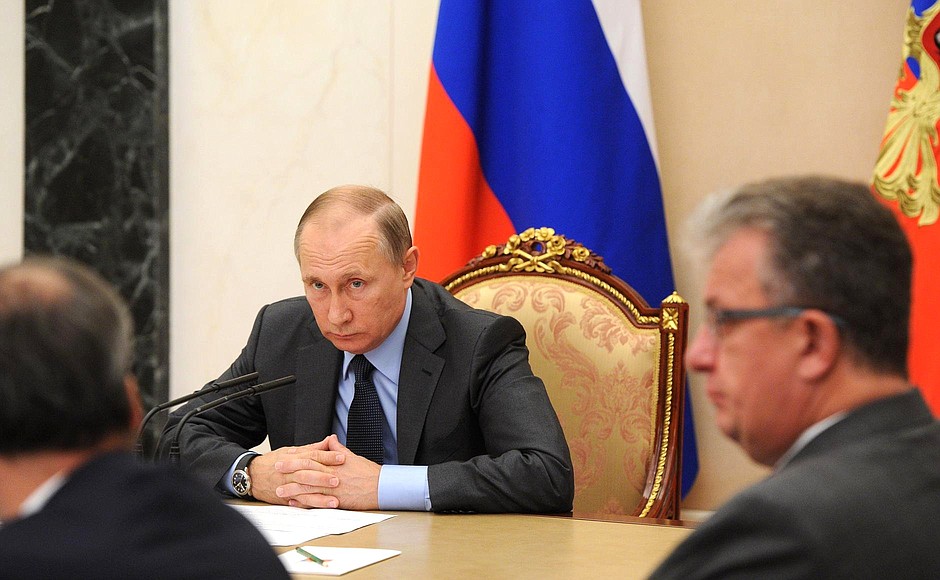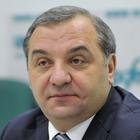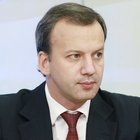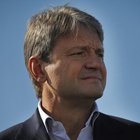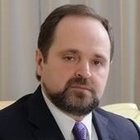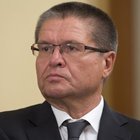President of Russia Vladimir Putin: Good afternoon colleagues.
We are going to discuss the Arctic today, but I would like to start with…
I discussed with the Emergency Situations Minister the need to help people in Vladivostok and Primorye Territory. We met in Vladivostok and I gave some specific instructions.
Mr Puchkov, what has been done so far and what is the situation now?
Emergency Situations Minister Vladimir Puchkov: Mr President, colleagues,
An emergency situation is still in place in Primorye Territory, as is the federal-level response. The authorities and our forces are working to minimise the flood damage.
We currently have more than 19,000 people and 1,150 pieces of equipment on location. In accordance with your instructions, we also have 1,800 people in reserve.
More than 40 settlements have been affected by the flooding, 4,500 houses with a population of 14,000 people. Forty-three settlements have been cut off from the outside world and communication links with 18 settlements are working only intermittently. The flooding has affected 10,500 hectares of agricultural land and damaged 70 bridges and more than 200 kilometres of roads.
Rescue work continues and initial repair work is underway. More than 200 people are currently living in temporary shelters. We have already closed three temporary shelters and sent people back to their homes.
The temporary shelters offer meals round the clock, medical services, and communication links. They have social workers and are able to sort out all current issues, including help in obtaining necessary documents.
We have established an air link using Mi-8 and Mi-26 helicopters, and more than 150 people have already been transported to Vladivostok and other regions. We have organised 7 temporary boat crossings and crossings using floating transporters. In the settlements where the water levels are subsiding now, 21 appraisal commissions are at work and so is a comprehensive brigade, rescue workers, who have already cleared sediment, mud and rubbish from more than 300 properties and organised targeted help for families.
Of course, our priority goes to the elderly and large families. We are vaccinating the local population. More than 1,800 people have already been vaccinated. Medical teams are working in all the affected settlements and more than 1,700 people have already received health check-ups.
Following a Government decision on Monday, 718.5 million rubles were allocated from the Reserve Fund. Mr President, this money is being used to provide material assistance to the flood victims and compensate for daily essentials lost in the flooding. The Primorye Territory budget is making the payments.
Our priority is to provide targeted help to the people and ensure rapid repair of important social infrastructure facilities such as schools and kindergartens wherever possible. Where this is not possible, the children have been sent to other educational facilities and their transport and studies have been organised.
The situation is still difficult in the region. Water levels continue to rise in a number of rivers and this is increasing the total flooded area.
Vladimir Putin: Are the rivers still rising?
Vladimir Puchkov: Yes, they are.
The appraisal commissions are at work. Mr President, we are working closely with all federal organisations. The Primorye Territory emergency situations commission and the local authorities are working hard, and the other Far East and Siberian regions are helping too.
Once the water levels have gone down, we will complete the damage assessment work and make additional decisions on rebuilding schools, kindergartens, homes, district hospitals and other socially important facilities.
Together with the Agriculture Ministry and the Transport Ministry, we considered the repair and restoration of roads and bridges and have earmarked 1.7 billion rubles for this work. We have already established integrated teams made up of specialists from different federal agencies. Specialists from the Communications, Construction, Agriculture and Transport ministries are at work on the ground drafting the pre-design concept.
We are working on the temporary restoration of all road and communication links and plan to have the design preparation and main work complete by September 2017, considering that very thorough work is required here to prepare the plans and ensure quality work.
Together with the Primorye Territory authorities, we have decided that the reconstruction work, especially in remoter rural areas, will result in infrastructure of a better quality than before the floods. The work continues and is being monitored by the National Crisis Situation Management Centre.
That ends my report.
Vladimir Putin: Mr Puchkov, it is difficult right now to assess the damage, especially to people’s property and homes?
Vladimir Puchkov: We have a general assessment based on preliminary information, but the problem is that water levels in the Ussuri River and several of its tributaries have continued to rise over the past 24 hours. In the areas where the water levels have gone down, 21 appraisal commissions are already at work and we are making progress step by step. So far, 304 homes are ready for living in again and we have cleaned out yards and brought in additional heat cannons from Sakahlin, Trans-Baikal Territory and Khabarovsk Territory. However, the final scale and specific decisions will be ready only once this latest wave of the elements subsides and the water levels go down.
Vladimir Putin: Good. You realise how important this is. Do not delay. Do everything as quickly as you can as soon as it is possible.
Vladimir Puchkov: Yes, Mr President.
(The next item on the agenda was the implementation of Government instructions on preventing the spread of contagious animal diseases, including African swine fever. Deputy Prime Minister Arkady Dvorkovich made a report and Minister of Natural Resources and the Environment Sergei Donskoy and Agriculture Minister Alexander Tkachev took part in the discussion).
Natural Resources and Environment Minister Sergei Donskoy: Mr President, colleagues,
The Russian Federation has laid claim to extending its Arctic continental shelf by 1.3 million square kilometres through extending the Russian continental shelf’s external border beyond the outer limit of the 200-mile exclusive economic zone.
In accordance with Article 76 of the United Nations Convention on the Law of the Sea, we sent our application to the UN Commission on the Limits of the Continental Shelf in August 2015. The Commission’s recommendations form the basis for delimiting neighbouring countries’ marine borders. It usually takes 3–5 years to examine an application. The Russian delegation is working to have our application examined by mid-summer next year.
In August this year, just recently, in other words, Russia presented its application to the UN sub-commission. The initial outcome of this presentation confirmed that the specialists would pay key attention to the justification for the way we have mapped the seabed relief. In this respect and in order to settle all possible questions, it is essential that the Defence Ministry complete this year its work on interpreting the bathymetric data obtained during the high latitude expeditions. We have held all the necessary consultations with the Defence Ministry now and they are to start on this.
The other Arctic countries are also very active in this area. In particular, Denmark has also made an application to the Commission and presented additional information just recently. The material they have presented covers 550,000 square kilometres of territory to which Russia has laid claim, including at the North Pole.
In this respect, to speed up the consideration of Russia’s application, it would be good to organise through Russian Foreign Ministry channels bilateral consultations with Denmark this autumn on signing an agreement on the preliminary delimitation of our adjacent continental shelf territories in the Arctic Ocean.
Vladimir Putin: With Denmark?
Sergei Donskoy: Yes, with Denmark, so as to then be able to organise the subsequent events, including proper examination of the geological applications, to avoid any further disputes. It would be good to do this in autumn this year.
Now I would like to say a few words about developing the Arctic region. We at the Natural Resources and Environment Ministry believe that the Arctic’s unique minerals and raw materials will be the driver for its development. Geologists have helped to develop a vast minerals and raw materials base here, including strategic minerals. A total 340 oil and gas fields have been discovered in the Arctic region, including 33 on the Arctic continental shelf. We have 407 hydrocarbon licences currently issued (these include both onshore and offshore production licences).
Vladimir Putin: Are these fields accessible?
Sergey Donskoy: As far as the Arctic shelf is concerned, the offshore fields are accessible. When we issued the licences, we also examined the territories’ accessibility. As of August 1 this year, we had 248 subsoil development licences issued in the Arctic region for geological exploration, development and production of solid minerals, and oil and gas prospecting is underway at 75 licenced offshore sites covering a total area of 1.3 million square kilometres in the Arctic region.
Given the substantial volume of work that state companies are currently carrying out or will carry out (we know that state companies are the main players operating on the continental shelf), and the macroeconomic instability we face right now, the Government decided to temporarily suspend new applications for offshore field development. This will allow companies to concentrate on carrying out their current licence obligations and to better distribute their financial resources while carrying out geological exploration.
As another step to clearly define subsoil resource users’ obligations for the geological exploration and development of the sites already under licence, Rosnedra [Russian Subsoil Resources Agency] is updating licences taking into account infrastructure projects implemented in the region. It was for this reason that we proposed a temporary freeze on issuing new licences, and the Government approved this decision.
The Arctic has 20 trillion cubic metres of proven natural gas reserves, mostly in the Yamal Peninsula area. The unique concentration of these resources requires us to take special measures to encourage timely work to start their development. If we fail to do this, Russia risks losing the chance to make full use of this potential for its own interests.
Increasing competition between different energy resources on the global energy markets makes it particularly important now to pursue maximum diversification of ways of using Russian natural gas. To achieve this we need to develop a package of measures, including licensing measures, to encourage a higher degree of natural gas processing and to develop LNG production and processing facilities in the region. We also need a mechanism for building transport and energy sector infrastructure facilities.
Mr President, I ask you to instruct the Government to work through this issue.
Another matter I would like to raise is an environmental one. In the past, natural resource development in the Arctic region was conducted without proper attention to the region’s fragile environment. Mr President, you saw the consequences when you visited Franz Josef Land in 2011.
In 2012, on your instructions, a general clean-up of the Arctic got underway. Franz Josef Land was chosen for the pilot project to eliminate the consequences of environmental damage in the Arctic. Environmental studies showed that around 90,000 tonnes of waste had accumulated there.
As a result of the work to clean up the accumulated environmental damage on the archipelago, over 2012–2015, 39,000 tonnes of waste was prepared for waste treatment and removed from the islands. This is around 44 percent of the total volume of waste. Alexandra Island has been totally cleared of waste. The project included the technical re-cultivation of 349 hectares of land. The Defence Ministry is involved in this work as well. They have organised clean-up work on the Novosibirsk Islands, Vrangel Island, and Novaya Zemlya. A total of more than 9,000 tonnes of scrap metal has been collected and around 150 hectares of damaged land have been cleaned up.
Mr President, given that this work began on your instructions, we would like to invite you to visit Alexandra Island on Franz Josef Land to see for yourself how the Arctic environment has changed after the clean up.
Vladimir Putin: It is getting cold there now.
Sergei Donskoy: You could visit next year, which will be the Year of the Environment next year — a good moment to inspect the results of the work done.
Vladimir Putin: It is not so bad right now, but in a couple of months, the temperatures will be very different.
Sergei Donskoy: Yes, there is a bit of the season left, until September 20, but after that, it will be difficult.
Vladimir Putin: There will not be time this year. Maybe next year, and this also will give more time to produce results.
Sergei Donskoy: Yes, Mr President.
Vladimir Putin: Thank you.
Mr Ulyukayev, you have the floor.
Economic Development Minister Alexei Ulyukayev: Mr President, colleagues,
The state commission examined the Arctic region’s development and came to the conclusion that the two main foundations for development are making use of the region’s unique minerals and raw materials base (primarily gas, oil, coal, non-ferrous metals, and rare earth elements), and developing on this basis modern industrial facilities, making use of the Northern Sea Route’s transit potential, and coupling these two aspects.
Economic activity in the region involves very specific conditions, of course. This includes economic activity focused around separate isolated sites, big distances and a localised infrastructure. We need to take a project-based approach here. Within our sub-commission of the commission on socioeconomic development examined the totality of projects the different agents have initiated and taken decisions on.
Work is already underway on some of them, and some of them, around 150, are in the development phase. Investment for these projects through 2030 will come to 5 trillion rubles. Obviously, we need to set priorities here. In other words, we will identify the projects that will get priority attention taking into account the current risks, results produced, and the possibilities for linking the projects.
In order to link projects and make use of the resulting synergy, we have approved a concept for support development zones in the Arctic region. These are the Kola, Chukotka, North Yakutia, Yamal, Taimyr and Nenets zones, where project development can use a common infrastructure base, which considerably reduces the initial financial costs.
Here, we could also develop public-private partnerships where the state would remove infrastructure restrictions and offer preferential treatment within the framework of the formats we have at our disposal, and businesses would take on investment commitments. This would help to optimise budget spending, involve the existing infrastructure in development, and make it possible to concentrate on several projects at once. We also propose using dual-purpose infrastructure facilities – transport, communications and energy facilities – in the interests of both defence and security development and economic development. We are working with the Defence Ministry on this.
Putting limited resources to maximum effective use requires the use of the different stimulating measures we have at our disposal: free ports, priority development areas, industrial parks and so on. In this respect, Mr President, we ask you to decide on the possibility, first, of extending the priority development area regime to the Arctic region in 2017. The law allows us to do this starting in 2020, but we would like to do this sooner.
Vladimir Putin: You mean the same thing we did in the Far East?
Alexei Ulyukayev: Yes, what we did in the Far East. We would like to extend it next year to the Arctic region.
Vladimir Putin: We will end up spreading this preferential regime to the entire country. This is all well and good, but then we will need to take some further measures in the Far East, because we must make an absolute priority of the Far East’s development, making it an attractive region for economic actors.
Alexei Ulyukayev: Mr President, this could be seen as the main development path. We are trying out the most effective ways of developing economic activity, territories, production potential and human resources in the Far East. It is a pilot project. Then we take what works best and spread it to other regions and make progress there too.
Second is the free port regime, which is working in Vladivostok and has been extended to another five Far East ports. We would like to extend this regime to the Northern Sea Route’s support ports – Pevek, Dikson and Tiksi.
Vladimir Putin: Not all of the Far East ports have been included in the free port regime, incidentally. Businesspeople were complaining that some port in Kamchatka, I think, had not been included.
Reply: On Sakhalin.
Vladimir Putin: Yes, on Sakhalin. This port should be included…
Presidential Aide Andrei Belousov: This is a non-diversified port — it is only used to ship coal.
Vladimir Putin: What difference does this make?
Andrei Belousov: If possible, we will consider this matter.
Vladimir Putin: Yes, do please. If the other ports all enjoy from certain preferences, there will be no more coal shipped there because everyone will go to the other ports. If neighbouring ports offer preferences and they do not, the port will start to die.
Examine the matter and brief me later on your conclusions.
Sorry, please continue.
Alexei Ulyukayev: We see this as links in a single chain, because transit via the Northern Sea Route makes use of the possibilities offered by the Far East ports and the Arctic Ocean ports. Freight volumes are increasing substantially in these areas and so is the export potential and transit opportunities for producers in the Far East. Of course, it is essential to use this potential for shipping the necessary winter supplies to the far northern regions too.
During the Soviet times, a large part of these supplies went via the Northern Sea Route, while today, most of the them come via the southern route, in other words, first by rail and then by river. This takes two seasons and is very costly. Of course, if we can make full use of the ports’ potential, it will substantially cut budget costs and will reduce the time it takes to ship supplies.
Vladimir Putin: Thank you.
<…>
